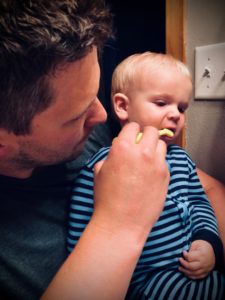Your Child’s Dental Health- The Early Years

Chris Schmaltz
Doctorate of Dental Surgery
This informal post offers guidance given from the perspective of a general dentist and a mental health professional that specializes with children. It also offers an empathetic perspective from these professionals who are married and navigating the challenges of caring for their own child’s dental health.

Christina Smestad-Schmaltz
MS, Licensed Marriage and Family Therapist
As a dentist, I am frequently asked the same questions and receive texts almost monthly from friends asking good questions like “What toothpaste should I use?” and “What should I do since my child isn’t brushing?” Providing adequate structure with dental hygiene can save hours worth of pain and inconveniences. Being engaged can also help your child potentially save thousands of dollars from the cost of dental care. My wife and I have learned a great deal from our respective professions and from being first-time parents. We hope our skill sets and experience can help you out also!
When should I start brushing my child’s teeth and what toothpaste should I use?
This is a fairly simple answer but as soon as a tooth breaks through the gingiva (gums) is a great time to start! The American Academy of Pediatric Dentistry has recommended children use toothpaste with fluoride in the amount of a grain of rice (compared to a pea-size amount for those over the age of 3). Brushing twice per day is the general recommendation. A tip I suggest is smearing the toothpaste into the brush bristles to reduce the ease of your child sucking the toothpaste off immediately. Flossing daily is also something that can be introduced at a young age, especially in areas the bristles of the toothbrush are unable to access. Lastly, we recommend parents be very mindful of dietary habits that could increase risk for caries (cavities).
It is important to start these hygiene practices in infancy in an effort for your child to offer a smoother transition for the new habit. This early introduction can yield much less headache for caregivers in the future. Babies are typically more open to new experiences than toddlers and tend to be more tolerant of caregivers having control over the brushing practices.

My child fights brushing. What do I do?
- Having two different options for a toothbrush
- Allowing the child to choose where to sit while brushing
- Allowing child to select the song to listen to while brushing
Labeled praise (positive reinforcement) is strongly recommended before, during and after brushing. Examples (as silly as they sound) include:
- “You’re doing such a great job walking to the bathroom to brush your teeth!”
- “I love the way you’re moving your toothbrush up and down while tickling your teeth!”
- “Look at the way you brushed your teeth and how clean they look, great job!”
Essentially, you want to add a lot of positivity and excitement to reinforce the behavior as well as be consistent. Children respond far better to positive reinforcement versus disciplinary techniques. As is with many things in child development, we want to give more energy into the behavior we want to see (through positive reinforcement) vs the behaviors we want to see less of (through scolding). One of the examples I use is from the Nurtured Heart Approach which demonstrates how children are drawn to the toys that light up and make noise. Thinking of ourselves as a toy, we want to light up and be excited when our child engages in behaviors we want to see. The alternative is to give less energy to the behaviors that are negative. Pairing a preferred activity after a non-preferred activity can also be a useful strategy. For example,
- “First we brush our teeth then we get to read a book.”
Stubborn behaviors are a challenge and the child may not understand the importance of maintaining good dental hygiene. The parent must continue to explore creative options that each child may respond to. I frequently emphasize we can’t always control every aspect of dental hygiene, but we can often control dietary habits since we are the ones buying the groceries. Minimizing high risk foods (sticky fruit snacks, crackers or chips) or beverages (soda, sports drinks or juices) is an important component of minimizing caries (cavities). We want to condense the exposure of the high risk foods into short time frames around meals and avoid frequent exposure throughout the day (snacking or going to bed with milk in a bottle). Please don’t feed your infant juices or soda! Nothing beats milk or water when it comes to beverages (as recommended by your pediatrician). Many city water treatment facilities foritfy fluoride (about .7 mg/L) which helps with development and protection of enamel. Yes, fluoride is a naturally occurring element in water! In dental school I used a sample of the well water from our farm to get tested. Although the concentration isn’t deemed as adequate, it contained .5 mg/L fluoride level. Integrating proper diet and dental hygiene will set your child up for a bright future!


